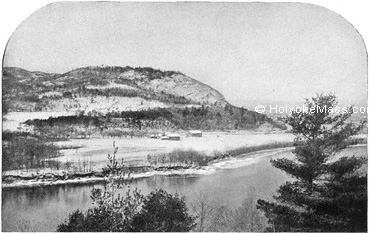water, in Governor Winthrop's vessel, the Blessing of the Bay, started, April 26, 1636, on their wilderness journey for their new home. The date of the arrival is not known, but by May 14 eight of the twelve original colonists of ancient Agawam had drawn up and signed the famous decree of distribution of the lands then purchased from the Indians, the deed of which, recorded at the Registry of Deeds' office of Hampden County, was the first executed in western Massachusetts. The valley in this region was peopled by several tribes or parts of tribes from the more eastern nations, one of which tribes, the Agawams or Springfield Indians, claimed all of the territory along both sides of the Connecticut between the Enfield falls below and the South Hadley falls above; and this was the section purchased from the sachems and distributed under the above decree, which provided that each person should have a home section on the east or Springfield side of the river, and another section on the other side as nearly opposite as might be. We can imagine these home sections as stretching along parallel with and not far from the present
Main street of the city; but it is not probable that the original boundaries, if definitely laid down, long remained, for the pioneers were soon followed by other settlers, who were doubtless welcomed to equal rights, cordial fellowship and a fair share of land. Here were set up their Puritan homes, their Puritan church, and their Puritan Sabbath. The territory conveyed to the original settlers in 1636 is that now embracing the towns of Longmeadow, Springfield, Chicopee and Ludlow on the east side of the river, and Agawam, West Springfield and Holyoke on the west side. Thus early began the English ownership of the domain forming the subject of this sketch. But our pioneer settlement, to which West Springfield and consequently Holyoke belonged, although invited and welcomed to their new home by then well-disposed savages, had at length to prove how unstable was their friendship and unite in a general movement for their expul-
© Laurel O'Donnell 1998 - 2006, all rights reserved
This document is an edited adaptation of the original publication and may be downloaded for personal non-commercial use only. These pages should not be reproduced or distributed in any format without permission. |

